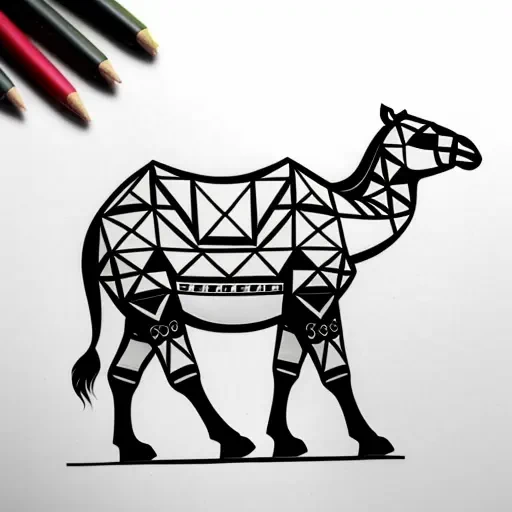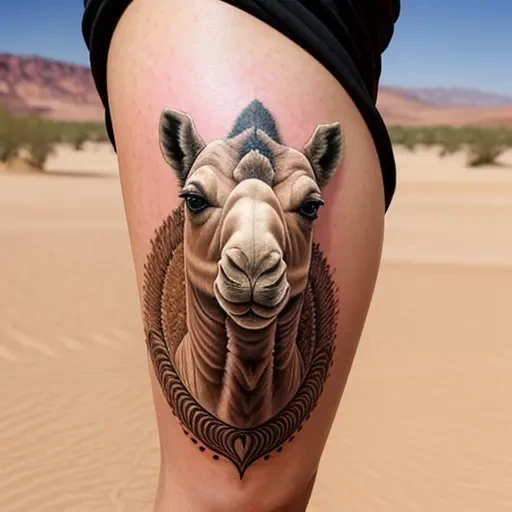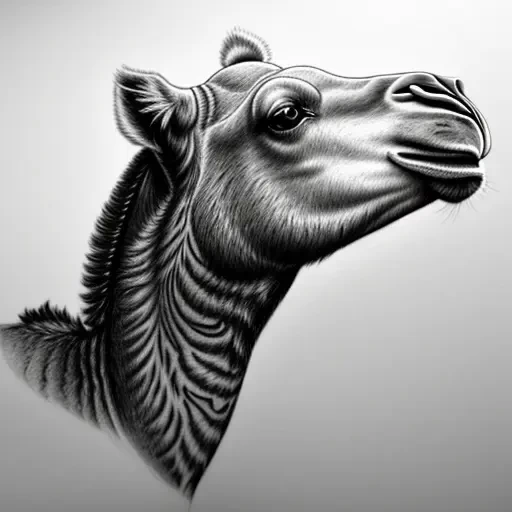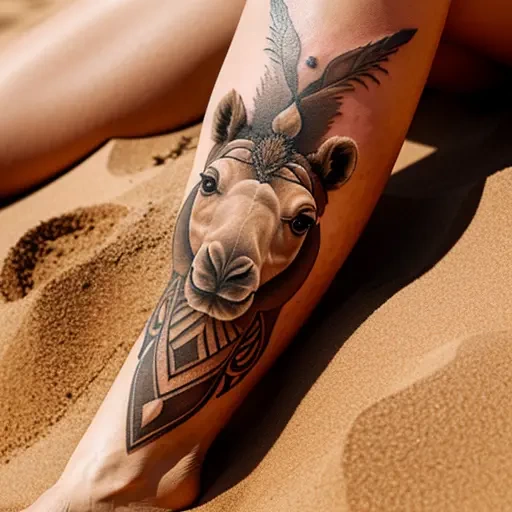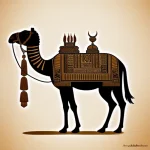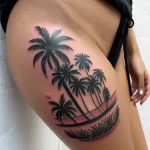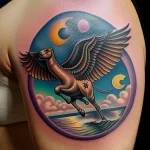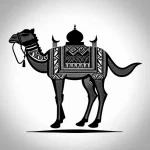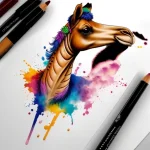Tattoos play a significant role in expressing individuality, beliefs, and values. The growing popularity of tattoos with animal motifs draws attention to symbols that carry deep philosophical meaning. One of these symbols is the camel tattoo. This desert inhabitant, symbolizing endurance and resilience, holds rich symbolism rooted in ancient times. In this article, we will explore the meaning of the camel tattoo, its interpretation, history, interesting facts, as well as the features and design options.
History of Camel Symbolism
Camel in Ancient Cultures
The camel is one of the oldest animals domesticated by humans. In desert regions such as the Middle East, North Africa, and Central Asia, the camel played a crucial role in the survival of local people. Its ability to travel long distances across lifeless deserts without water or food made it a symbol of resilience and endurance.
Ancient Egypt and Mesopotamia
In ancient Egyptian and Mesopotamian cultures, the camel symbolized strength, hard work, and importance in trade. These animals were used in caravans, transporting goods over vast distances, becoming an integral part of the economic system. The camel also symbolized adaptability to harsh conditions, making it a symbol of survival.
Middle East and Islamic Culture
In the Middle East, the camel became an important cultural symbol. In Islamic culture, the camel is associated with patience, endurance, and devotion. Since camels played a significant role in the lives of the Bedouins, they became symbols of life force and endurance in religious texts and legends.
Camel in Modern Culture
In today’s world, the camel remains a symbol of endurance and adaptability to harsh conditions. In tattoo culture, this symbol reflects both individual and collective experiences. The camel can represent inner strength, the ability to overcome difficulties, survival in challenging circumstances, and even life’s journeys.
The Meaning of Camel Tattoos
Key Meanings of the Tattoo
A camel tattoo carries a range of meanings, which may vary depending on the context. Let’s explore the main interpretations:
- Endurance and Resilience: The camel is an animal capable of surviving in the harshest conditions. In a tattoo, it symbolizes resilience in the face of life’s challenges and the ability to bear great burdens, both physical and emotional.
- Adaptation and Survival: The camel’s ability to adapt to extreme conditions, withstand heat, and survive long periods without water has made it a symbol of survival and flexibility. For those who have faced difficult life circumstances, this symbol can serve as a reminder of their ability to adapt and overcome any challenges.
- Longevity and Patience: The camel symbolizes the ability to wait and store strength for overcoming long life “deserts.” The tattoo can express a desire for patience and wisdom in waiting for better times.
- Spiritual Journey and Travels: In some cultures, the camel is associated with spiritual quests and journeys through life’s paths. A camel tattoo can become a symbol of an inner journey, searching for meaning, and striving for personal growth.
- Freedom and Independence: The camel, which often travels through endless deserts, can also symbolize freedom and independence. For many people, this animal is a symbol of freedom from constraints and the pursuit of self-reliance.
Personal Meaning of the Tattoo
For each person, a camel tattoo can carry unique, personal significance. Some choose this symbol after overcoming significant life hardships or events, as a symbol of their inner strength and ability to recover. Others may see in this animal echoes of their desire for freedom, independence, and self-sufficiency.
Camel Tattoo Design Options and Their Features
Popular Tattoo Styles
Camel tattoos can be done in various styles, from realism to more abstract and stylized depictions. Let’s consider the most popular options:
Realism
In a realistic style, a camel tattoo is depicted with maximum detail. Every feature of the animal—from its fur to facial expressions—is meticulously worked on by the artist. This style is ideal for those who want to create a deep and meaningful image that conveys the characteristics of a real camel. These tattoos are usually done in color or black-and-white.
Geometric Style
Geometric tattoos have gained immense popularity in recent years due to their symmetry and abstraction. In this style, the camel can be portrayed with geometric elements—triangles, lines, circles—which give the design a unique artistic expression. This style emphasizes the balance between the natural beauty of the animal and the strict logic of geometry.
Traditional Technique (Old School)
Traditional style tattoos, also known as old school, are characterized by bold lines, bright colors, and simple yet expressive designs. A camel in this style may be depicted with an emphasis on its strength and endurance. This style is perfect for those who appreciate classic tattoo designs and want to add a retro element to their look.
Minimalism
Minimalist camel tattoos may be done as simple silhouettes or outline designs. This style is especially popular among people who prefer subtle and unobtrusive tattoos. Minimalism in a camel design can emphasize elegance and restraint, while maintaining deep symbolism.
Animalism
Animalism-style tattoos focus on naturalistic depictions of animals. A camel in this style may be portrayed against a backdrop of natural landscapes, deserts, or oases, adding extra depth to the composition. Animalistic tattoos perfectly convey the spirit of nature and the connection between humans and the wild.
Color Choices
Camel tattoos can be done in both color and black-and-white. Each approach has its advantages, and the choice depends on the wearer’s preferences.
- Color Tattoos: Color tattoos bring the design to life and add realism. Orange and sandy desert tones, the greenery of oases, and the camel’s brown hues can create a vibrant image. Color tattoos emphasize the natural habitat of the camel and its significance to desert cultures.
- Black-and-White Tattoos: Black-and-white tattoos are more subdued and highlight contrast and shading. These tattoos may look more graphic and minimalist, focusing on the shapes and lines of the design.
Tattoo Placement
A camel can be depicted in both large and small formats, and the placement depends on the size and style of the tattoo.
- Shoulder or Back: For larger tattoos with many details, the shoulder or back are ideal locations. These areas provide enough space for creating a complex composition with the camel and elements of the landscape.
- Forearm: The forearm is a great spot for placing either a large camel image or a minimalist design. This location allows the tattoo to be visible yet not too overwhelming.
- Chest or Ribs: These areas are suitable for those who want to hide their tattoo or make it more personal. The chest offers room for both detailed and minimalist designs.
- Leg or Ankle: On the leg, especially the thigh or ankle, smaller or medium-sized camel tattoos can be placed. This spot is ideal for those who prefer more delicate and refined tattoos.
Interpretation of Camel Tattoos in Different Cultures
Eastern Symbolism
In Eastern cultures, especially in Islamic countries, the camel symbolizes patience, endurance, and resilience. In religious texts, the camel is mentioned as a symbol of the strength and wisdom needed to overcome life’s difficulties. A camel tattoo in this context can symbolize spiritual growth and the pursuit of harmony with the world.
Western Culture
In the West, the camel is typically associated with exoticism, travel, and endurance. In Western tattoo culture, the camel can symbolize freedom, adventure, and the ability to overcome obstacles on the way to a goal. The camel is also linked to the idea of a life journey, where each step leads to a new goal despite challenges.
African Culture
In African cultures, particularly in the northern parts of the continent, the camel plays a crucial role in the lives of nomadic people. It symbolizes not only physical endurance but also the ability to survive in the harsh conditions of the desert. For African peoples, the camel represents the strength of nature and harmony with the environment. A camel tattoo in the African tradition can be a symbol of respect for nature and the desire to live in harmony with it.
Interesting Facts About Camels and Their Symbolism
- Camels can survive without water for up to two weeks, making them a symbol of endurance and adaptation to extreme conditions. In a tattoo, this can symbolize inner strength and the ability to handle difficulties.
- Camels are one of the first domesticated animals. They were domesticated around 3,000 BC and have played a significant role in the lives of many peoples ever since.
- In some cultures, camels are a symbol of wealth and status. In some nomadic societies, the number of camels reflects a family’s wealth.
- Camels can remember their owners for many years. This trait has made them a symbol of loyalty and devotion.
A camel tattoo is a powerful symbol that embodies ideas of endurance, resilience, patience, and adaptation to life’s hardships. Whether you choose a realistic style or a minimalist depiction, a camel tattoo can reflect deep personal beliefs and life paths. It’s important to choose the style, placement, and symbolism of the tattoo in a way that reflects the individual’s inner world, making it a source of inspiration for many years.
